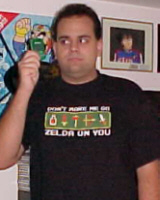 Inside
Virtua Racing
Inside
Virtua Racing
-David, webmaster DVGI

 Inside
Virtua Racing
Inside
Virtua Racing
-David, webmaster DVGI
The most expensive commercially released 16 bit game ever made is the Sega Genesis port of the first true 3D polygonal Sega Model 1 racing game, Virtua Racing. Yes, games like Hard Drivin' were in 3D, but they were simulations as opposed to real racing. Virtua Racing was basically a brightly colored high speed 3D polygonal arcade racing game, based loosely on Formula 1 style cars. It was the predecessor to Daytona USA which would really demonstrate the power of the Sega Model 2 arcade hardware and go on to be the most popular arcade racing game even today, 10 years after its release. When Virtua Racing hit the arcades they were actually going through a bit of a revival in the United States. The hologram laserdisc games had just come out, fighting games were beginning to get really popular, and a fresh crop of new arcades was being built throughout Silicon Valley.
At the time, the Sega Genesis was in the
lead of the 16 bit console wars, ahead of Nintendo. Of course Sega
wanted to port over the hottest racing game of the time to their home console,
the Genesis. However Virtua Racing had smooth scaling, nicely rendered
polygons, and a rock solid frame rate - how could that possibly be made
to work on aging 16 bit hardware? The answer was the development
of the SVP chip, or Sega Virtua Processor. SVP Technology was the
Sega version of Nintendo's Super FX chip (used in games such as StarFox
and Stunt Race FX on the Super Nintendo) however the SVP did things more
efficiently. Basically the SVP chip was a Samsung SSP1601 DSP core.
The cost to develop and create the new technology was so expensive that
when Virtua Racing finally did hit the stores it retailed for no less than
$120. (this was back when SNES 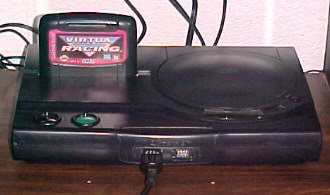 and
Genesis games were about $70 a pop - and you complain about game prices
now days) Virtua Racing on the Genesis plays surprisingly smooth
and fluid with a decent frame rate. In other words the game is completely
playable and enjoyable - a kick in the face to Checkered Flag which was
a very similar game released on the 64 bit Atari Jaguar, however the controls
and frame rate were so bad in Checkered Flag that it was nearly unplayable.
Scaling with the SVP chip was much smoother and faster than the Super Nintendo's
Super FX chip which had horribly unstable frame rates. There was
talk of the SVP being used in other games but this never happened.
Virtua Racing on the Genesis was soon eclipsed by Virtua Racing Deluxe
on the Sega 32X and a lackluster port simply titled Virtua Racing on the
Sega Saturn. By then though, everyone was too wrapped up with Daytona
USA to notice.
and
Genesis games were about $70 a pop - and you complain about game prices
now days) Virtua Racing on the Genesis plays surprisingly smooth
and fluid with a decent frame rate. In other words the game is completely
playable and enjoyable - a kick in the face to Checkered Flag which was
a very similar game released on the 64 bit Atari Jaguar, however the controls
and frame rate were so bad in Checkered Flag that it was nearly unplayable.
Scaling with the SVP chip was much smoother and faster than the Super Nintendo's
Super FX chip which had horribly unstable frame rates. There was
talk of the SVP being used in other games but this never happened.
Virtua Racing on the Genesis was soon eclipsed by Virtua Racing Deluxe
on the Sega 32X and a lackluster port simply titled Virtua Racing on the
Sega Saturn. By then though, everyone was too wrapped up with Daytona
USA to notice.
Enough about the content of the title and the story about the game, this is a quick explanation of what you're getting into when you buy a Virtua Racing cartridge for the Genesis. I recently picked up a copy of this, one of my favorite arcade games, for about five bucks at the local used game store. Since I now have a JVC X'Eye I can start to build up a Genesis archive again but only of the titles I really want or can find cheaply. I've almost purchased a full sized two seat Virtua Racing arcade machine four times, so this home port is a nice addition both because of the history behind it and because I really enjoy the game. However there are a few things to take into consideration when you buy a used copy from an unknown owner. (this includes used game stores since you don't know the journey the cartridge took before arriving there)
First, the Virtua Racing cartridge is BIG, it's even bigger than the large Genesis cartridges and is about double the size of a normal one. This means that it may be easy to bump the cartridge while it is inside the Genesis, leading to the game locking up or crashing. This goes double for playing it in a JVC X'Eye since it has a larger import-friendly cartridge slot. If the game locks up or crashes during gameplay it probably only lost connection to the console, you have to be patient with this cartridge.
Second, since the SVP generated so much heat, it was equipped with a rather large heat sink. Given how long ago these cartridges were made (10+ years) the thermal compound that links the SVP chip to the heat sink and helps transfer heat away is probably no longer any good. If you use a security bit to open up the cartridge and remove the tape holding the shielding paper you will find the heat sink. A slight wiggle will cause it to break free from the SVP chip and you will be left with the old thermal compound residue on each.
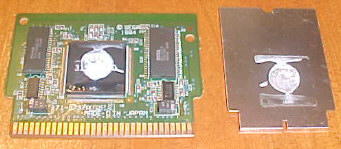
Carefully clean off ALL of the thermal compound from both the heat sink and the SVP chip, a slightly damp paper towel followed by a dry paper towel will usually do the job. Make sure it's totally clean until it looks like the picture below.
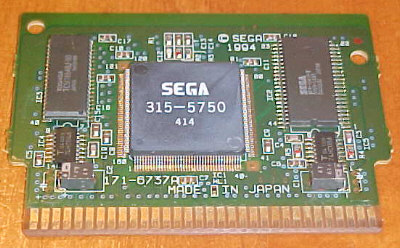
While the cartridge is open you may want to take a moment to clean the connectors with some cartridge cleaner or a slightly damp paper towel, make sure to be careful not to damage any of the components on the cartridge. Then apply a THIN coat (I mean as thin as you can get it) of thermal heat sink compound to the SVP chip. You can find this at most computer or electronic stores, it's the same goop that is used between computer processors and heat sinks. Then line the heat sink back up and gently but firmly press it to the SVP chip, it'll still be a little slick, don't worry about this.
Place the shielding paper back around the cartridge and heat sink and tape it tightly with a new piece of tape. Then set the cartridge back into the plastic cartridge housing, the curve at the top of the heat sink rests against the raised nub inside the cartridge housing while the holes in the cartridge sit around the other nubs. Put the two cartridge housing halves back together and secure the screws. I'd recommend letting the cartridge sit for at least an hour before playing, just so the thermal compound can have a chance to set.
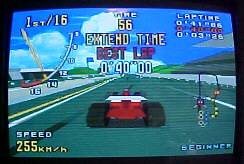 With
that you should be good to go, your Virtua Racing cartridge will last another
ten years. You'll still have to watch out for bumping the cartridge
as an occasional game crash due to this will happen sooner or later.
However that's just one of the quirks of the Genesis version of this arcade
classic. Virtua Racing is the only Sega Genesis game no where remotely
close to being supported by the current generation Genesis emulators, so
the only way to play this specific version of Virtua Racing is on the actual
cartridge. While it's not super rare it is indeed quite uncommon
and can be obtained now days for a very modest price. It's simple
enough, if you see a copy of Virtua Racing for the Genesis you should pick
it up as long as it's not being sold for some astronomical amount.
Just for the record, yes the Sega 32X version plays slightly smoother and
has two new circuits that weren't in the arcade, and yes the Sega Saturn
version was somewhat close to the arcade version however it was really
a mixed bag. Hopefully the arcade perfect home port (right down to
the attract screens) of Virtua Racing that Sega released on the PS2 in
Japan this year will show up on our shores eventually. Still, Virtua
Racing on the Genesis is an interesting attempt to further the technology
of the time, something Sega did quite a lot of in the 1990's.
With
that you should be good to go, your Virtua Racing cartridge will last another
ten years. You'll still have to watch out for bumping the cartridge
as an occasional game crash due to this will happen sooner or later.
However that's just one of the quirks of the Genesis version of this arcade
classic. Virtua Racing is the only Sega Genesis game no where remotely
close to being supported by the current generation Genesis emulators, so
the only way to play this specific version of Virtua Racing is on the actual
cartridge. While it's not super rare it is indeed quite uncommon
and can be obtained now days for a very modest price. It's simple
enough, if you see a copy of Virtua Racing for the Genesis you should pick
it up as long as it's not being sold for some astronomical amount.
Just for the record, yes the Sega 32X version plays slightly smoother and
has two new circuits that weren't in the arcade, and yes the Sega Saturn
version was somewhat close to the arcade version however it was really
a mixed bag. Hopefully the arcade perfect home port (right down to
the attract screens) of Virtua Racing that Sega released on the PS2 in
Japan this year will show up on our shores eventually. Still, Virtua
Racing on the Genesis is an interesting attempt to further the technology
of the time, something Sega did quite a lot of in the 1990's.
Written on 12-18-04 by David, insanedavid@classicplastic.net
Last amended on 12-04-07 by David, insanedavid@classicplastic.net